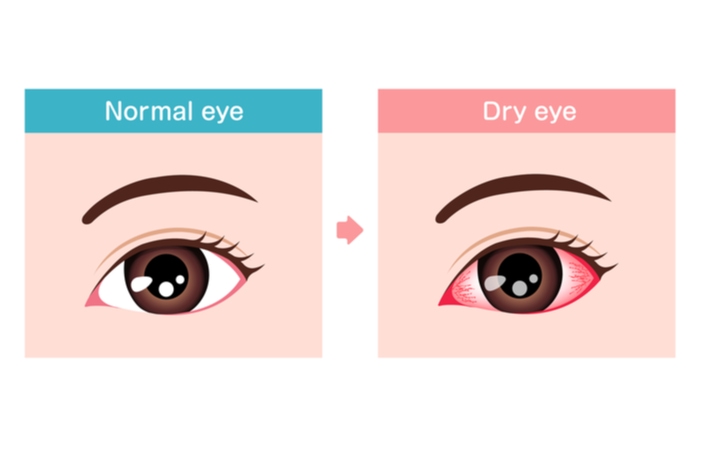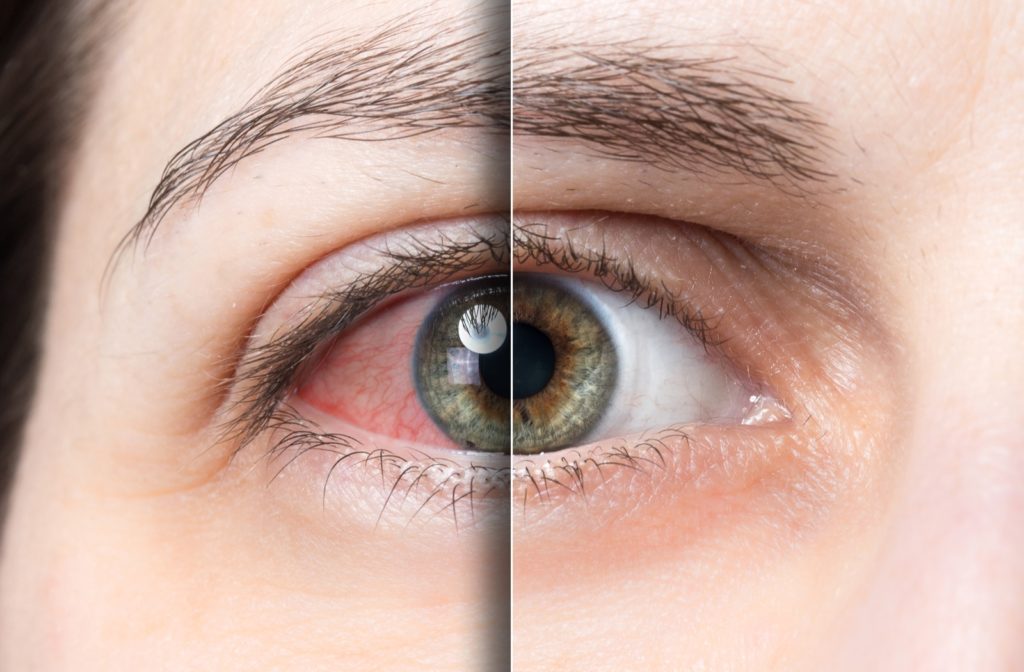Can an underlying medical condition cause dry eye syndrome?
Dry eyes are a common and typically chronic condition many people seek relief from. There are many reasons this condition occurs, but can an underlying medical condition be the cause of your dry eyes?
Continue reading to learn more about dry eyes, including if underlying medical conditions can affect dry eye disease development.
What is Dry Eye Disease?
Dry eye disease is a common condition where your tears cannot effectively lubricate your eyes. Your tears spread across the eye’s surface each time you blink. They help by providing moisture, reducing the risk of infection, washing away debris, and keeping your eye smooth and clear.
Your tear film is vital for keeping your eyes protected and healthy, but complications can arise and impact its functionality. When there is a problem in one of the tear film’s layers (oil, aqueous fluid, mucin), it can result in irritated and dry eyes. This condition can lead to inflammation and damage to your eye’s surface.
Dry Eye Disease Symptoms
Dry eye disease can result in several symptoms developing. They usually affect both eyes, and common signs of dry eyes include:
- Eyes that sting, burn, or feel scratchy
- Stringy mucus in or around the eyes
- Light sensitivity
- Eye redness
- Foreign object sensation
- Difficulty wearing contact lenses
- Watery eyes
- Blurred vision
- Eye fatigue
What Causes Dry Eyes?
There are 2 common types of dry eye disease: aqueous deficient dry eye and evaporative dry eye. Other factors that put you more at risk of dry eyes include:
- Age
- Gender
- Diet
- Contact lens use
Both forms of dry eyes have several potential causes. If you’re experiencing symptoms of dry eye disease, can an underlying medical condition be the cause of your irritation?
Can an Underlying Medical Condition Cause Dry Eyes?
Dry eyes occur for many reasons. Complications can happen in one of the 3 layers of the tear film, affecting its ability to keep your eye’s surface lubricated. The cause of your dry eyes is related to a decrease in tear production or an increase in tear evaporation.
Decreased Tear Production
Also known as aqueous deficient dry eye disease, decreased tear production occurs when you can’t produce enough aqueous fluid for your tears. Several medical conditions can affect your ability to produce quality tears, including:
- Sjogren’s syndrome
- Allergic eye disease
- Rheumatoid arthritis
- Lupus
- Scleroderma
- Graft vs. host disease
- Sarcoidosis
- Thyroid disorders
Besides these conditions, aging is a common cause of decreased tear production. Another cause of inadequate tear production is side effects from antihistamines, decongestants, antidepressants, and acne medication.

Increased Tear Evaporation
Increased tear evaporation, or evaporative dry eye disease, happens when there are issues with the oily layer of the tear film. This oil helps prevent your tears from drying out. When the glands that release this oil becomes compromised, you may experience dry eye symptoms.
Some medical conditions related to this form of dry eye disease include meibomian gland dysfunction, entropion, and ectropion. Besides these conditions, other reasons for increased tear evaporation include:
- Blinking less
- Eye allergies
- Preservatives in eye drops
- Wind, smoke, or dry air
- Vitamin A deficiency
Many medical conditions can increase your likelihood of developing dry eyes. Regardless of the reason for your dry eyes, you likely want to relieve your symptoms. Your optometrist has several treatments they can recommend.
Dry Eye Disease Treatments
There are many different treatments available to help address your dry eyes. Your optometrist will determine the best options for your needs after assessing your eyes during a comprehensive eye exam. Some of these treatments include intense pulsed light, TearCare, and BlephEx.
Intense Pulsed Light (IPL)
Intense pulsed light (IPL) helps treat meibomian gland dysfunction, a common cause of increased tear evaporation. IPL releases wavelengths of light to warm the meibomian glands during treatment, removing blockages.
The wavelengths released are a scattered pulse of light that helps treat inflammation within your eye. Restoring functionality to the meibomian glands helps your tears stay on the eye’s surface for longer. This treatment improves tear breakup time in 87% of patients.
TearCare
TearCare is a device that heats your eyelids to remove clogged meibomian glands. It’s a blink-assisted treatment that is comfortable, providing a spa-like experience. After heat treatment finishes, your optometrist may manually express your meibomian glands.
BlephEx
BlephEx is a treatment designed for blepharitis and dry eye disease. It provides gentle exfoliation to help remove dry and flaky skin. Treatment features a Q-tip-like device that helps clean your eyelids, helping reduce bacteria and providing relief from symptoms.
Your optometrist has many ways to address dry eye disease and help improve your tear functionality. They can determine the most effective options during an eye exam.
Find Relief From Dry Eyes
Dry eyes can lead to inflammation and damage to your eye’s surface, but you don’t need to live with these symptoms. Your optometrist can help you effectively address dry eye disease.
If you have symptoms of dry eye disease, contact your eye doctor.



